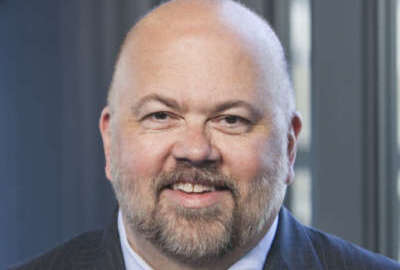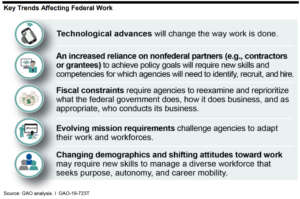
Shake up government with an agile organization and workforce
If we take some agile concepts and apply them to how government is organized and staffed, we may see that many criticisms of shortcomings can be addressed.
This column was originally published on Jeff Neal’s blog, ChiefHRO.com, and was republished here with permission from the author.
Recent Government Accountability Office testimony before the House of Representatives, Talent Management Strategies to Help Agencies Better Compete in a Tight Labor Market, highlighted several challenges the government faces as it competes for talent in an increasingly tight labor market. GAO identified five key trends.

To address those challenges, GAO made the following recommendations:
- Align human capital strategy with current and future mission requirements. Agencies need to identify the knowledge and skills necessary to respond to current and future demands. Key practices include identifying and assessing existing skills, competencies, and skills gaps.
- Acquire and assign talent. To ensure the appropriate capacity exists to address evolving mission requirements, agencies can use internships, cultivate a diverse talent pipeline, highlight their respective missions, and recruit early in the school year.
- Incentivize and compensate employees. While agencies may struggle to offer competitive pay in certain labor markets, they can leverage existing incentives that appeal to workers’ desire to set a schedule and to work in locations that provide work-life balance.
- Engage employees. Engaged employees are more productive and less likely to leave, according to the Office of Personnel Management (OPM). Agencies can better ensure their employees are engaged by managing their performance, involving them in decisions, and providing staff development.
The trends GAO identified are a good sample of the many challenges the government faces, and their recommendations were a good start. But when we look at the challenges in talent management and performance, I do not think fixing hiring and strengthening employee engagement are enough. Those employees will still be stuck in unresponsive organizations that look much like they did five, ten or twenty years ago. Government organizations tend to be inflexible, and jobs are often narrowly defined and stay the same for years. Many are reorganized periodically, but those reorgs do not change the character or inflexible nature of the organization. They are just rearranging the boxes and where people sit.
Those inflexible organizations exist is a world that is awash in change. Technology is evolving at such a pace that government may struggle to catch up, let alone stay current. Mission demands will also continue to change, as will the demographics of the nation and the attitudes toward work. Government is not even remotely prepared to keep up with those changes, and their ability to do so is likely to get worse before it gets better.
In an interconnected world where virtually any information you need is literally in the palm of your hand, government is hierarchical, not effective at sharing information, and not designed to evolve with mission, technology and workforce changes. Organizations could be designed with flexibility in mind, but few in government are. They can have job descriptions that are adaptable, but few are. They can listen to their employees, but many do not.
At the same time that everything around them is changing, the federal workforce is aging rapidly. The number of workers over age 60 is increasing, while new hires of people under age 30 continue to fall short of what is needed. The government is also developing a gap in midcareer employees. The number of workers between ages 45 and 54 decreased by more than 40,000 in the past 4 years. When an organization has a weak pipeline of young hires and a hollowing out of the middle, the future is grim.
As if that were not enough, federal employee bashing as a political activity is increasing. Politicians referring to career employees as “the deep state” and calling for reductions in workers in many departments are making it less likely that people in high-demand occupations will choose the federal government as an employer.
The trends and government’s organization and talent management policies add up to a great deal of risk. If the economy continues to produce jobs, the government will struggle to compete for talent, and will have difficulty keeping the people it has. The aging workers are going to age out of the workforce, so there will be big holes to fill. And the government’s unwillingness or inability to be more agile in its management and organization practices will make it difficult to keep up.
One potential solution is to apply some of the principles of agile project management to government organizations. While agile may be overhyped, the approach does include several concepts that are particularly adaptable to organization and talent issues. Ideas like satisfying customers by early and continuous delivery of solutions, welcoming change, and building organizations and projects around trusted, motivated individuals apply to more than software development and project management. Greater use of face-to-face conversations, a focus on simplicity and maximizing the amount of work not done are also concepts that can apply to how jobs and organizations work. So are self-reflection and focus on how to become more effective.
Imagine government organizations that focus on customers and continually adapt to meet their needs. How about trusting the employees who know the work? And reducing hierarchy and allowing more flexible, self-managing teams? Why not have job descriptions that are far more focused on what people should know and the results they should achieve, rather than being lists of unchanging duties that are never current and rarely accurate?
Government gets far too many unfounded complaints about its shortcomings and federal workers take the blame for problems politicians create, but it is true is that government is too rigid, too unwilling to adapt, and too comfortable with the status quo. If we take some agile concepts and apply them to how government is organized and staffed, we may see that those criticisms can be addressed. Taxpayers will be better off and federal workers will have better working conditions.
Copyright © 2024 Federal News Network. All rights reserved. This website is not intended for users located within the European Economic Area.
Related Stories

OPM policy changes may improve hiring, but only if agencies do not find ways to maintain the status quo




